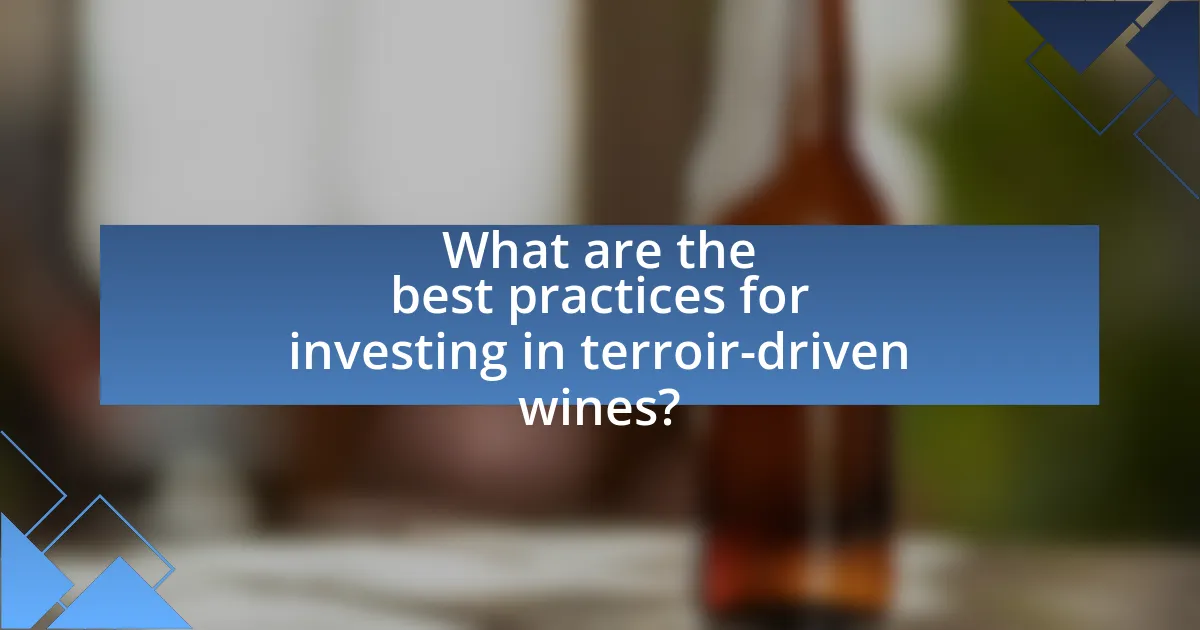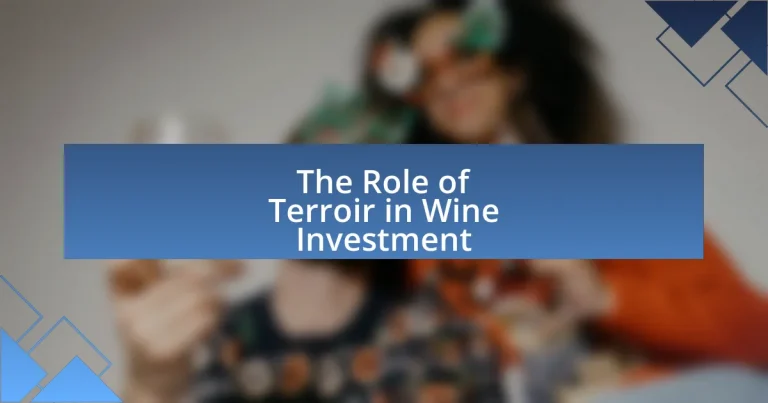The article examines the critical role of terroir in wine investment, highlighting how factors such as soil, climate, topography, and local traditions influence the quality, character, and market value of wines. It discusses the significance of understanding terroir for investors, emphasizing its impact on wine valuation and market trends. Key components of terroir are outlined, including climate and soil types, and the article addresses the risks associated with neglecting terroir in investment decisions. Additionally, it provides insights on assessing terroir, identifying high-potential regions, and best practices for investing in terroir-driven wines.

What is the Role of Terroir in Wine Investment?
Terroir plays a crucial role in wine investment by influencing the quality, character, and market value of wines. Terroir encompasses the unique combination of soil, climate, topography, and local traditions that affect grape growing and wine production. For instance, wines from renowned regions like Bordeaux or Burgundy often command higher prices due to their distinct terroir, which is recognized for producing exceptional grapes. Historical data shows that wines from specific terroirs can appreciate significantly over time; for example, the average price of top Bordeaux wines has increased by over 200% in the last two decades, reflecting the impact of terroir on investment potential.
How does terroir influence the quality of wine?
Terroir significantly influences the quality of wine by encompassing the unique environmental factors of a specific vineyard location, including soil composition, climate, and topography. These elements affect grape growth and development, leading to distinct flavor profiles and characteristics in the wine produced. For instance, studies have shown that vineyards in regions with well-drained soils and optimal sunlight exposure yield grapes with higher sugar levels and acidity, which are crucial for producing high-quality wines. Additionally, the concept of terroir is supported by the fact that wines from the same grape variety can taste markedly different when grown in different regions, highlighting the impact of local conditions on the final product.
What are the key components of terroir?
The key components of terroir are climate, soil, topography, and human influence. Climate affects grape ripening and flavor development, with factors such as temperature, rainfall, and sunlight playing crucial roles. Soil composition, including mineral content and drainage, directly influences vine health and grape characteristics. Topography, including elevation and slope, impacts sunlight exposure and air drainage, which can affect grape quality. Human influence encompasses vineyard management practices, including pruning, irrigation, and harvesting techniques, which can enhance or detract from the natural qualities imparted by the other components. These elements collectively shape the unique characteristics of wines produced in a specific region, making terroir a fundamental concept in viticulture and wine investment.
How do climate and soil types affect wine characteristics?
Climate and soil types significantly influence wine characteristics by affecting grape growth, flavor profiles, and overall wine quality. Climate determines temperature, sunlight, and rainfall, which directly impact the ripening process of grapes; for instance, warmer climates often produce riper, fruitier wines, while cooler climates yield wines with higher acidity and more delicate flavors. Soil types contribute minerals and nutrients essential for vine health, with specific soils like limestone enhancing acidity and structure, while clay soils retain moisture, benefiting grape development. Research indicates that regions like Bordeaux, with its diverse soils and temperate climate, produce distinct wine styles, showcasing the critical role of terroir in defining wine characteristics.
Why is understanding terroir important for wine investors?
Understanding terroir is crucial for wine investors because it directly influences the quality, character, and market value of wines. Terroir encompasses the unique environmental factors, including soil composition, climate, and topography, that affect grape cultivation. For instance, wines from regions with distinct terroirs, such as Bordeaux or Burgundy, often command higher prices due to their perceived quality and rarity. Historical data shows that wines from specific terroirs can appreciate significantly over time, making them attractive investment opportunities. Therefore, a comprehensive understanding of terroir enables investors to make informed decisions, identify high-potential wines, and assess their long-term value in the market.
How does terroir impact wine valuation?
Terroir significantly impacts wine valuation by influencing the unique characteristics of the wine, which can enhance its desirability and market price. Terroir encompasses factors such as soil composition, climate, and topography, all of which contribute to the flavor profile and quality of the wine. For instance, wines from renowned regions like Bordeaux or Burgundy often command higher prices due to their established reputation for exceptional terroir, which is supported by historical data showing that wines from these areas consistently achieve higher auction prices compared to those from lesser-known regions. This correlation between terroir and wine valuation is further evidenced by studies indicating that wines with a strong sense of place, or terroir, are perceived as more authentic and desirable by consumers, thereby increasing their market value.
What role does terroir play in market trends?
Terroir significantly influences market trends in the wine industry by shaping the unique characteristics of wines that consumers seek. The concept of terroir encompasses the environmental factors, such as soil, climate, and topography, that affect grape cultivation, leading to distinct flavor profiles and quality. For instance, wines from renowned regions like Bordeaux or Burgundy often command higher prices due to their perceived quality linked to specific terroirs. According to a study published in the Journal of Wine Economics, wines from recognized terroirs can achieve price premiums of up to 30% compared to similar wines from less prestigious regions. This demonstrates that terroir not only affects the sensory attributes of wine but also plays a crucial role in consumer preferences and investment decisions, driving market trends towards wines that embody specific terroir characteristics.
What are the risks associated with ignoring terroir in wine investment?
Ignoring terroir in wine investment poses significant risks, primarily leading to poor investment decisions and financial losses. Terroir, which encompasses the unique environmental factors affecting grape cultivation, directly influences wine quality and market value. For instance, wines from renowned regions like Bordeaux or Burgundy command higher prices due to their established reputations linked to specific terroirs. Neglecting these factors can result in investing in wines that lack the potential for appreciation, as they may not possess the distinctive characteristics that collectors and investors seek. Historical data shows that wines from recognized terroirs consistently outperform those from lesser-known regions in terms of price appreciation, underscoring the importance of terroir in making informed investment choices.
How can poor terroir choices lead to financial loss?
Poor terroir choices can lead to financial loss by negatively impacting the quality and marketability of wine. When vineyards are established in unsuitable locations, factors such as soil composition, climate, and drainage can hinder grape growth, resulting in lower-quality wines. For instance, a study by the University of California, Davis, highlights that wines produced from grapes grown in optimal terroirs can command prices up to 50% higher than those from less favorable conditions. Consequently, poor terroir decisions can diminish a vineyard’s reputation, reduce sales, and ultimately lead to significant financial setbacks for wine investors.
What historical examples illustrate the importance of terroir?
Historical examples that illustrate the importance of terroir include the classification of Bordeaux wines in 1855 and the establishment of the AOC (Appellation d’Origine Contrôlée) system in France in the 20th century. The 1855 Bordeaux classification ranked wines based on their terroir, emphasizing the unique characteristics imparted by the region’s soil, climate, and grape varieties, which directly influenced their market value. Similarly, the AOC system, introduced to protect the integrity of regional wines, highlighted how specific terroirs contribute to the quality and identity of wines, reinforcing the notion that geographical origin significantly affects wine investment and consumer perception.

How can investors assess terroir when selecting wines?
Investors can assess terroir when selecting wines by evaluating the geographical, climatic, and soil characteristics of the vineyard. Terroir encompasses the unique environmental factors that influence grape growing, including altitude, proximity to bodies of water, and local weather patterns. For instance, regions like Bordeaux are known for their specific soil types, such as gravel and clay, which contribute to the quality of the wine produced. Additionally, historical performance data of wines from specific terroirs can provide insights; for example, wines from Burgundy often appreciate in value due to their distinct terroir and limited production. Understanding these elements allows investors to make informed decisions about the potential quality and investment value of wines.
What factors should investors consider when evaluating terroir?
Investors should consider climate, soil composition, topography, and vineyard management practices when evaluating terroir. Climate influences grape ripening and flavor development, with regions like Bordeaux benefiting from a temperate maritime climate that enhances wine quality. Soil composition affects drainage and nutrient availability; for instance, the limestone soils of Burgundy contribute to the region’s renowned Pinot Noir. Topography, including elevation and slope, impacts sunlight exposure and temperature variations, which can enhance grape characteristics. Lastly, vineyard management practices, such as organic farming or precision viticulture, can significantly influence the quality of the grapes produced, thereby affecting the overall investment potential.
How do vineyard location and elevation influence wine quality?
Vineyard location and elevation significantly influence wine quality by affecting climate, soil composition, and grape ripening. Specific locations can provide optimal sunlight exposure and temperature variations, which are crucial for developing the desired flavors and aromas in grapes. For instance, vineyards situated on slopes benefit from better drainage and increased sun exposure, leading to more concentrated flavors. Elevation plays a critical role as well; higher altitudes often result in cooler temperatures, which can slow down grape ripening, allowing for more complex flavor development. Research indicates that vineyards at elevations above 1,000 meters can produce wines with higher acidity and enhanced aromatic profiles, as seen in regions like the Andes in Argentina. Thus, both vineyard location and elevation are essential factors in determining the overall quality of wine produced.
What role do local winemaking traditions play in terroir assessment?
Local winemaking traditions significantly influence terroir assessment by integrating cultural practices, historical knowledge, and specific techniques that shape the characteristics of the wine produced in a region. These traditions often dictate vineyard management practices, such as grape selection, fermentation methods, and aging processes, which directly affect the expression of terroir. For instance, in regions like Burgundy, the use of traditional methods such as whole-cluster fermentation and specific barrel aging contributes to the unique flavor profiles associated with its wines. This connection between local practices and the resulting wine quality underscores the importance of winemaking traditions in accurately assessing terroir, as they provide context and depth to the sensory attributes derived from the land.
How can technology aid in the analysis of terroir?
Technology aids in the analysis of terroir by utilizing advanced tools such as Geographic Information Systems (GIS), remote sensing, and soil sensors to gather and analyze data on environmental factors affecting wine production. GIS allows for the mapping of vineyard locations and their specific climatic conditions, while remote sensing provides real-time data on vegetation health and soil moisture levels. Soil sensors measure pH, nutrient levels, and moisture content, enabling precise management of vineyard practices. These technologies enhance understanding of how specific terroir characteristics influence grape quality and ultimately wine investment decisions, as evidenced by studies showing that terroir significantly impacts wine flavor profiles and market value.
What tools are available for assessing soil and climate conditions?
Tools available for assessing soil and climate conditions include soil moisture sensors, pH meters, and climate monitoring stations. Soil moisture sensors provide real-time data on water content, which is crucial for understanding irrigation needs. pH meters measure the acidity or alkalinity of the soil, affecting nutrient availability for plants. Climate monitoring stations collect data on temperature, humidity, and precipitation, enabling analysis of microclimates that influence grape growing conditions. These tools are essential for viticulture, as they help optimize vineyard management and enhance wine quality.
How can data analytics enhance understanding of terroir’s impact?
Data analytics can enhance understanding of terroir’s impact by providing quantitative insights into the relationship between environmental factors and wine characteristics. By analyzing data such as soil composition, climate conditions, and vineyard management practices, researchers can identify specific terroir attributes that influence flavor profiles and quality. For instance, a study published in the journal “OENO One” demonstrated that data analytics could correlate temperature variations and soil types with the phenolic content of grapes, thereby linking terroir to wine quality metrics. This analytical approach allows winemakers and investors to make informed decisions based on empirical evidence, ultimately optimizing wine production and investment strategies.

What are the best practices for investing in terroir-driven wines?
The best practices for investing in terroir-driven wines include understanding the specific characteristics of the terroir, researching the reputation of the vineyard, and evaluating the wine’s aging potential. Terroir encompasses the unique environmental factors, such as soil composition, climate, and topography, that influence the wine’s flavor profile and quality. Investing in wines from well-regarded regions, such as Bordeaux or Burgundy, can yield higher returns due to their established market demand. Additionally, wines that demonstrate strong aging potential, often indicated by their structure and balance, tend to appreciate in value over time. Historical data shows that wines from prestigious terroirs have consistently outperformed others in the market, making them a sound investment choice.
How can investors identify high-potential terroirs?
Investors can identify high-potential terroirs by analyzing specific environmental factors such as climate, soil composition, and topography. These factors significantly influence grape quality and, consequently, wine value. For instance, regions with a Mediterranean climate, like Bordeaux, are known for producing premium wines due to their ideal temperature and rainfall patterns. Additionally, soil types such as limestone and clay are proven to enhance grape characteristics, as seen in Burgundy, which is renowned for its Pinot Noir and Chardonnay. Historical performance data, including past wine prices and critical ratings from wine experts, can also guide investors in recognizing terroirs with a strong track record of producing sought-after wines.
What regions are currently recognized for their exceptional terroir?
Regions currently recognized for their exceptional terroir include Bordeaux in France, Napa Valley in the United States, Tuscany in Italy, and the Barossa Valley in Australia. Bordeaux is renowned for its diverse microclimates and soil types that contribute to the complexity of its wines, particularly Cabernet Sauvignon and Merlot. Napa Valley benefits from a Mediterranean climate and varied elevations, enhancing the quality of its Cabernet Sauvignon and Chardonnay. Tuscany is famous for its Sangiovese grapes, which thrive in its unique soil and climate conditions. The Barossa Valley is celebrated for its old vine Shiraz, benefiting from a warm climate and rich soils. These regions are consistently acknowledged in wine investment circles for their ability to produce high-quality wines that reflect their distinct terroir.
How can emerging terroirs be evaluated for investment opportunities?
Emerging terroirs can be evaluated for investment opportunities by analyzing factors such as climate, soil composition, and historical performance of similar regions. Climate data indicates that regions with stable weather patterns and adequate rainfall are more likely to produce high-quality grapes, which can lead to better investment returns. Soil composition, particularly the presence of minerals and drainage capabilities, directly affects grape quality; for instance, regions with limestone or clay soils have historically produced renowned wines. Additionally, examining the historical performance of established wine regions can provide insights into the potential growth of emerging terroirs, as regions that have shown consistent quality and demand tend to attract investment. For example, the rise of regions like Napa Valley and Barossa Valley demonstrates how emerging terroirs can evolve into lucrative investment opportunities when they meet these criteria.
What strategies can investors use to mitigate risks related to terroir?
Investors can mitigate risks related to terroir by diversifying their wine portfolios across various regions and vintages. This strategy reduces the impact of localized climate events or soil issues that may affect specific terroirs. For instance, investing in wines from both Bordeaux and Burgundy allows investors to balance potential losses from one region with gains from another, as historical data shows that different regions can perform variably under changing climate conditions. Additionally, conducting thorough research on the specific characteristics and historical performance of wines from different terroirs can inform better investment decisions, further minimizing risk.
How can diversification across terroirs enhance investment portfolios?
Diversification across terroirs can enhance investment portfolios by reducing risk and increasing potential returns. Different terroirs produce wines with unique characteristics influenced by climate, soil, and geography, leading to varied performance in the market. For instance, wines from Bordeaux may perform differently than those from Burgundy or Napa Valley due to their distinct profiles and consumer demand. Historical data shows that during economic downturns, certain regions may outperform others, providing a buffer against market volatility. By investing in a range of terroirs, investors can capitalize on these differences, achieving a more stable and potentially lucrative portfolio.
What role does expert consultation play in terroir investment decisions?
Expert consultation plays a crucial role in terroir investment decisions by providing specialized knowledge and insights that inform investors about the unique characteristics of a specific vineyard site. Experts analyze factors such as soil composition, climate, and topography, which are essential for determining the potential quality and market value of wine produced from that terroir. For instance, studies have shown that vineyards in regions with optimal climatic conditions and soil types can yield wines that command higher prices in the market, thus validating the importance of expert input in making informed investment choices.
What are the key takeaways for successful terroir-based wine investment?
Successful terroir-based wine investment requires a deep understanding of the specific characteristics of the vineyard’s location, including climate, soil, and topography. Investors should prioritize regions known for their unique terroir, such as Bordeaux or Burgundy, which have historically produced high-quality wines that appreciate in value. Additionally, focusing on established producers with a track record of excellence can mitigate risks, as these wineries often have a loyal customer base and consistent demand. Market trends indicate that wines from well-defined terroirs tend to perform better in auctions and resale markets, reinforcing the importance of terroir in investment decisions.


